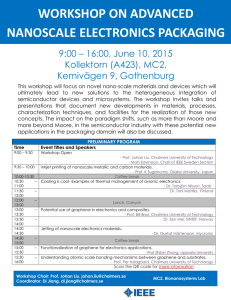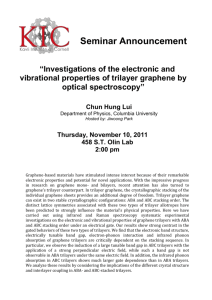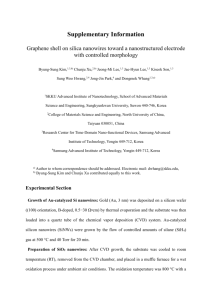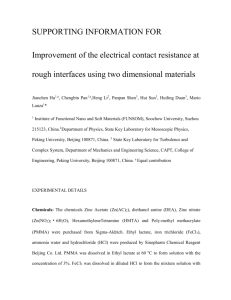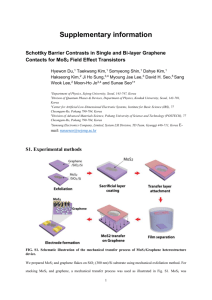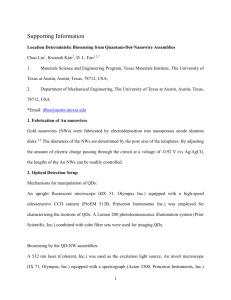More information about topics and speakers
advertisement
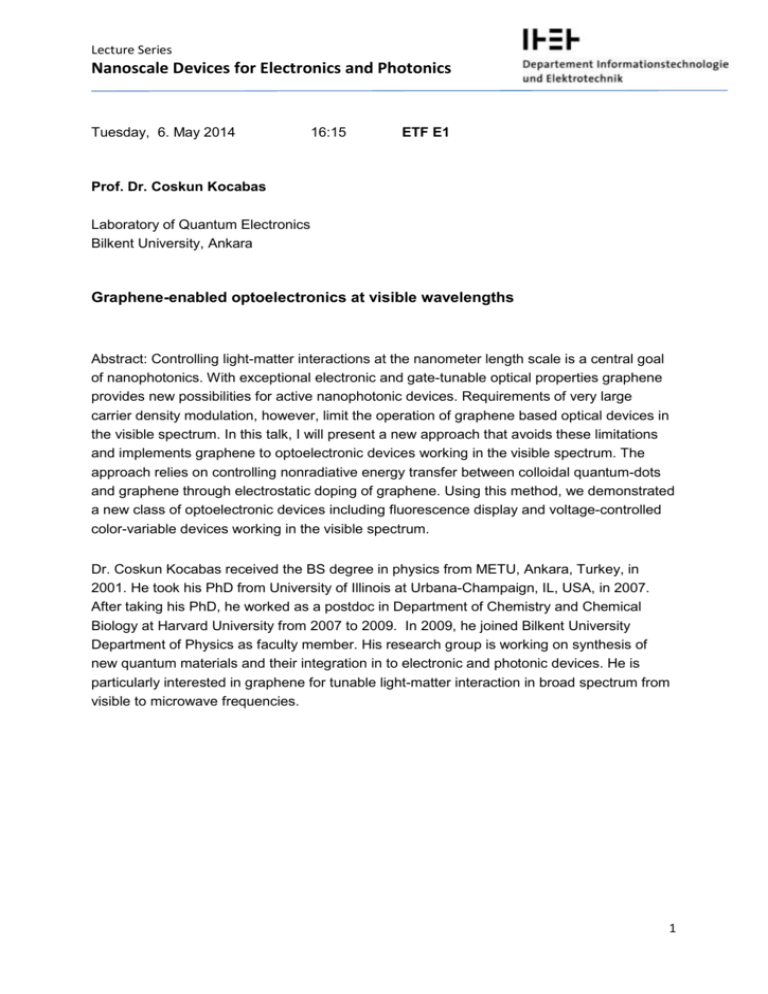
Lecture Series Nanoscale Devices for Electronics and Photonics Tuesday, 6. May 2014 16:15 ETF E1 Prof. Dr. Coskun Kocabas Laboratory of Quantum Electronics Bilkent University, Ankara Graphene-enabled optoelectronics at visible wavelengths Abstract: Controlling light-matter interactions at the nanometer length scale is a central goal of nanophotonics. With exceptional electronic and gate-tunable optical properties graphene provides new possibilities for active nanophotonic devices. Requirements of very large carrier density modulation, however, limit the operation of graphene based optical devices in the visible spectrum. In this talk, I will present a new approach that avoids these limitations and implements graphene to optoelectronic devices working in the visible spectrum. The approach relies on controlling nonradiative energy transfer between colloidal quantum-dots and graphene through electrostatic doping of graphene. Using this method, we demonstrated a new class of optoelectronic devices including fluorescence display and voltage-controlled color-variable devices working in the visible spectrum. Dr. Coskun Kocabas received the BS degree in physics from METU, Ankara, Turkey, in 2001. He took his PhD from University of Illinois at Urbana-Champaign, IL, USA, in 2007. After taking his PhD, he worked as a postdoc in Department of Chemistry and Chemical Biology at Harvard University from 2007 to 2009. In 2009, he joined Bilkent University Department of Physics as faculty member. His research group is working on synthesis of new quantum materials and their integration in to electronic and photonic devices. He is particularly interested in graphene for tunable light-matter interaction in broad spectrum from visible to microwave frequencies. 1 Lecture Series Nanoscale Devices for Electronics and Photonics Wednesday, 14. May 2014 16:15 ETF E1 Prof. Dr. Joerg Appenzeller Electrical and Computer Engineering Purdue University, West Lafayette, Indiana Two-Dimensional Layered Materials – Physics and Applications Abstract: With 2D materials offering unique opportunities for future nanoelectronics applications, the quest is to identify their useful properties and potential intrinsic performance benefits. While the most commonly studied 2D system, i.e. graphene, has excited scientists because of high achievable carrier mobilities, the absence of a band gap makes many device related applications very challenging. On the other hand materials as MoS2, WSe2, or WS2, to just name a few, offer sizable bandgaps at mobilities that cannot be achieved in bulk materials that are scaled down to similar thicknesses. In my presentation I will discuss the benefits of an ultra-thin body structure for scaled device applications. I will also elucidate the critical impact of contacts to benefit from the intrinsic performance of MoS2 based field-effect transistors (FETs). Our study supports in particular the notion that an apparently linear device Id-Vds characteristic is by no means evidence of an Ohmic contact and that contacts frequently mask the true mobility specs of novel low-dimensional materials. Moreover, I will present experimental results on the scaling properties of MoS2 FETs and the impact of the layer thickness as well as the choice of layer thickness for device applications. Dr. J. Appenzeller received the M.S. and Ph.D. degrees in physics from the Technical University of Aachen, Germany in 1991 and 1995. His Ph.D. dissertation investigated quantum transport phenomena in low dimensional systems based on III/V heterostructures. He worked for one year as a Research Scientist in the Research Center in Juelich, Germany before he became an Assistant Professor with the Technical University of Aachen in 1996. During his professorship he explored mesoscopic electron transport in different materials including carbon nanotubes and superconductor-semiconductor-hybride devices. From 1998 to 1999, he was with the Massachusetts Institute of Technology, Cambridge, as a Visiting Scientist, exploring the ultimate scaling limits of silicon MOSFET devices. From 2001 until 2007, he had been with the IBM T.J. Watson Research Center, Yorktown, NY, as a Research Staff Member mainly involved in the investigation of the potential of carbon nanotubes and silicon nanowires for a future nanoelectronics. Since 2007 he is Professor of Electrical and Computer Engineering at Purdue University and Scientific Director of Nanoelectronics in the Birck Nanotechnology Center. His current interests include novel devices based on low-dimensional nano-materials as nanowires, nanotubes, graphene and di-chalcogenides. 2 Lecture Series Nanoscale Devices for Electronics and Photonics Tuesday, 3. June 2014 16:15 ETZ E6 Dr. Heike E. Riel Manager Materials Integration and Nanoscale Devices - MIND IBM Research – Zurich, Zurich, Switzerland Semiconducting Nanowires – From Materials to Devices Abstract: Approaching fundamental limits in scaling-down conventional silicon microelectronic devices forces the semiconductor industry to research and develop novel materials, device geometries and physical mechanisms. In that regard, bottom-up grown nanowires are very attractive materials for direct integration of III-V semiconductors on silicon thus opening up new possibilities for the design and fabrication of future electronic and optoelectronic devices. In particular, the nanowire geometry allows the growth of abrupt heterostructures with large lattice mismatch and offers an ideal geometry for field-effect transistors (FETs) from an electrostatic integrity perspective. In this presentation I will give an overview about our activities in the field of semiconducting nanowires. I will briefly review our work on III-V nanowire growth including doping and material characterization, demonstrating the challenges and opportunities of the nanowire approach. In addition, device fabrication and electrical characterization of nanowire-based devices such as FETs, tunnel diodes and Tunnel FETs as steep slope devices for low power applications will be discussed. Dr. Heike Riel is IBM Fellow and is leading the Materials Integration and Nanoscale Devices Group at IBM Research – Zurich. Her current interests include new materials and novel device concepts for future nanoelectronics, in particular, semiconducting nanowires for applications in electronics, optoelectronics and energy harvesting and molecular electronics. Heike Riel studied physics at the Friedrich-Alexander University of Erlangen-Nuremberg (Germany) and received a PhD from the University of Bayreuth (Germany) in 2003 for her work on the optimization of multilayer organic light-emitting devices. After an internship at the Hewlett-Packard Research Laboratory, Palo Alto, she joined the IBM Zurich Research Lab in 1998 as a PhD student, and became a Research Staff Member in 2003. Since 2008 she has been leading the Nanoscale Electronics Group and in 2013 she has been appointed IBM Fellow. For her outstanding scientific contributions she was elected by Technology Review, MIT’s Magazine of Innovation, to the TR100, the annual list of the world’s 100 Top Young Innovators in September 2003 and she received the 2005 Applied Physics Award of the Swiss Physical Society. In June 2012 she received the award in the category “Technical or Scientific Innovation” which was awarded by the Swiss Association of Women in Engineering (SVIN) on the occasion of their 20th anniversary and in 2013 she was offered a Humboldt Professorship. 3

